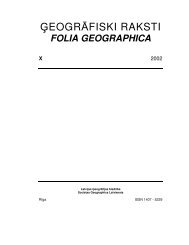eogrÄfiski raksti folia geographica xii - Ä¢eogrÄfijas un Zemes zinÄtņu ...
eogrÄfiski raksti folia geographica xii - Ä¢eogrÄfijas un Zemes zinÄtņu ...
eogrÄfiski raksti folia geographica xii - Ä¢eogrÄfijas un Zemes zinÄtņu ...
Create successful ePaper yourself
Turn your PDF publications into a flip-book with our unique Google optimized e-Paper software.
19<br />
NATURE RESEARCH<br />
masses or at a gradual transformation of an air mass a bo<strong>un</strong>dary cannot be drawn. Frontal<br />
passage is connected with a sharp discontinuity in temperature and humidity values at the<br />
surface and the 850 hPa level, but within one air mass the same weather remains for several<br />
days or at least one day. Distinctive air masses show different types of weather and it strongly<br />
depends on the season. There are various hydrometeors or visible water manifestations<br />
following vapour condensation in the atmosphere, e.g. fog, clouds, rain, snow, mist, which are<br />
observed both in a frontal zone and within an air mass.<br />
The labor-consuming nature of air mass identification and the lack of any preliminary<br />
study of that kind in Latvia were the main reasons for the relatively short duration of the period<br />
subjected to investigation. Besides, the most complete 850 hPa charts were available only from<br />
the last decade of the 20 th century, because the DWD began to deliver European Meteorological<br />
Bulletins to the Latvian Hydrometeorological Agency only after restoration of Latvia’s<br />
independence. The Bulletins contain, along with Europe’s surface weather charts at 00 UTC and<br />
surface weather charts of the Northern Hemisphere at 12.00 UTC, also the 850 hPa 12.00 UTC<br />
chart. However, the period 1990-2000 turned out to be the warmest on record and, in order to<br />
encompass the whole set of air masses that may affect Latvia, the study sometimes had to be<br />
extended back to 1987 [Draveniece 2003].<br />
Each air mass is a widespread body of air and it covers an area which is commonly larger<br />
than the territory of Latvia. It is true that the same air mass over landforms of different relief<br />
(uplands, lowlands) and <strong>un</strong>der the influence of other <strong>geographica</strong>l factors may produce different<br />
amo<strong>un</strong>ts of precipitation or exert distinctive effects on the surface temperature. Yet this aspect<br />
and transitional conditions during passage of atmospheric fronts (transition zones between<br />
different air masses) are not treated in this work. Besides, the differences in the annual cycle<br />
and seasonal variations in different parts of Latvia are only slightly touched upon. The study is<br />
for the greatest part gro<strong>un</strong>ded on the observations and measurements performed in the central<br />
part of Latvia (Riga), and consequently the findings should be mainly attributed to the central<br />
region. However, discussing the results of this study, an emphasis is put on the facts and<br />
conclusions which might be significant for the whole of Latvia and even for the entire boreonemoral<br />
ecotone.<br />
3. The cycle of the seasons induced by the zonal pattern of insolation<br />
3.1. The periods of negative and positive net radiation<br />
The net radiation (Rnt) is the solar energy absorbed by the earth (land and water surface).<br />
The annual course of net radiation (Rnt) clearly shows two periods: on average for four<br />
months – from the end of October through the second half of February – the mean diurnal Rnt is<br />
negative in Latvia, and during the remaining eight months it is positive (Figure 2).<br />
The term negative Rnt means that the influx of solar radiation to the earth’s surface<br />
(incoming short-wave radiation or insolation) doesn’t exceed the total amo<strong>un</strong>t of reflected shortwave<br />
and the emitted outgoing long-wave radiation (difference between the net long-wave<br />
radiation at the surface and atmospheric co<strong>un</strong>ter-radiation, primarily by clouds). As result, the<br />
heat and water turnover in the landscape is very limited, the majority of living beings<br />
experience biological dormancy, and a great part of migratory birds have left Latvia. The mean<br />
diurnal sum of Rnt is positive, when the incoming short-wave radiation exceeds the energy lost<br />
to space. Therefore heat may be gained and accumulated in atmosphere through vigorous<br />
turbulent updrafts from the land and water along with intensive evaporation and active life<br />
processes are possible.<br />
The seasonal changes of insolation and net radiation stem from the annual course of daylength<br />
and the height of the S<strong>un</strong>, which depend on <strong>geographica</strong>l latitude. However, the influence<br />
of this factor is strongly modified by atmosphere circulation, which brings to the territory of<br />
Latvia both maritime and continental air masses that have originated in different latitudes and<br />
therefore differ greatly by their heat content, moisture, wind speed and particularly by cloud<br />
cover. Therefore the annual course of net radiation is much like the curve of s<strong>un</strong>shine duration,

















